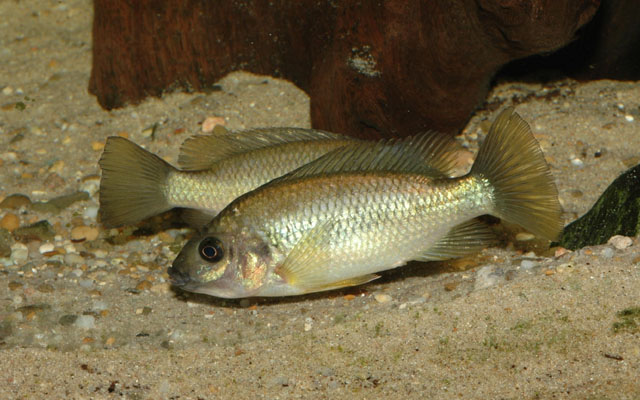| Cichlidae (Cichlids), subfamily: Pseudocrenilabrinae |
| 11.3 cm SL (male/unsexed) |
|
demersal; freshwater |
| Africa: endemic to Lake Barombi Mbo, West Cameroon (Ref. 52307, 81260). |
|
Dorsal spines (total): 16-17; Dorsal soft rays (total): 10-11; Anal spines: 3-3; Anal soft rays: 8-10; Vertebrae: 29-31. Diagnosis: 19-23 rakers on lower limb of first arch (Ref. 81260). Length of lower pharyngeal jaw 40-50% of head length (Ref. 81260), width 34.5-38.0 (Ref. 2). Pearly yellow in life, with no markings on body; preserved specimens dark grey on back, with a horizontal darker band in some; decurved snout (Ref. 2).
Description: head length 33.0-36.5% SL; lower pharyngeal jaw with unicuspid anterior teeth and pointed posterior teeth; ventral keel elongate, as long as dentigerous plate; 2-4 rows of teeth in oral jaws, outer row teeth bicuspid (Ref. 81260).
Coloration: base body color yellowish, grey-blue dorsally and whitish ventrally; juveniles with round "tilapia spot", bordered with a pale band; "tilapia spot" disappears at lengths of about 40 mm SL (Ref. 81260). Dark mid-lateral stripe extending from posterior edge of opercle to end of caudal peduncle often visible; fins usually clear, rarely opaque (Ref. 52307). |
| Seems to prefer shallow areas near the edges of the lake (Ref. 52307). Occurs in schools at the surface; stomach of specimens which were examined contained organic debris; benthic and epilithic diatoms, and sponge spicules were nearly always present and many had inorganic particles in the stomach; individuals were seen shoveling sand into the mouth, moving it about in the buccopharynx, then spitting out the sand and making swallowing movements (Ref. 2). Lacks marked sexual dichromatism when sexually active (Ref. 81260). Probably a biparental ovophilic mouthbrooder that forms little to no (Ref. 52307) and only temporary pair bonds (Ref. 81260). |
|
Critically Endangered (CR); Date assessed: 16 February 2009 (B1ab(iii)+2ab(iii)) Ref. (130435)
|
| harmless |
Source and more info: www.fishbase.org. For personal, classroom, and other internal use only. Not for publication.
